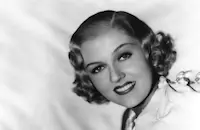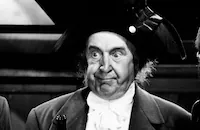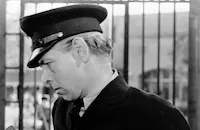The Narrow Corner

Brief Synopsis
Cast & Crew
Alfred E. Green
Douglas Fairbanks
Patricia Ellis
Ralph Bellamy
Dudley Digges
Arthur Hohl
Film Details
Technical Specs

Synopsis
Capt. Nichols is hired in Sydney, Australia to keep Fred Blake at sea until some trouble blows over. They sail through the South Pacific, avoiding contact with Europeans, until they meet Dr. Saunders at a Dutch colony. Delighted to find someone who can help his "dyspepsia," Nichols overrides Fred's objections to Saunders' presence and allows the doctor to sail with them. At sea, they are caught in a fierce storm, but the ship comes through with only a little damage. They anchor off an island, and Fred swims to shore, where he meets an attractive British woman, Louise Frith, and her friend, Eric, a Dane who also lives on the island. Louise invites Fred and his companions to her father's house for dinner, where they meet her grandfather, a former skipper. It becomes clear that Fred and Louise are attracted to one another, but when Eric tells Fred that he and Louise are secretly engaged, Fred avoids her because of his growing friendship with Eric. One day, however, she joins him on board his ship, and their mutual attraction overcomes his scruples. In response to her questions, he tells her he is running away because he accidentally killed another woman's husband. When Eric sees Fred leaving Louise's room, he rushes after him and tries to strangle him. Fred passes out, and Eric thinks he has killed him and, horrified, shoots himself. Fred is not dead, however, and when the police learn about the events in Sydney, they suspect him of Eric's murder. He decides to escape, even though a storm is brewing. Without Fred's knowledge, Louise has hidden on board his ship. She guides him through the dangerous reefs, and with one arm on the wheel and one around her shoulders, Fred sails away to a new life.

Director
Alfred E. Green
Cast

Douglas Fairbanks

Patricia Ellis

Ralph Bellamy

Dudley Digges

Arthur Hohl

Reginald Owen

Henry Kolker

Wm. V. Mong
Willie Fung

Sidney Toler

Joseph Swickard
Crew

Videos
Movie Clip



Trailer
Film Details
Technical Specs

Articles
The Narrow Corner
"A little gem from the wide-open pre-Code era" is how film historian William K. Everson described The Narrow Corner during a 1973 exhibition at Manhattan's New School. One of only sixteen features released that year by Warners, the production was shot in 28 days by Alfred E. Green, with Catalina Island (and a bit of the studio's Burbank back lot) subbing for the South Seas. The star of the show was Douglas Fairbanks, Jr., in his last assignment as a Warners contract player. Given unprecedented perks by the studio after his success in Howard Hawks' The Dawn Patrol (1930), Fairbanks fils was on the down-slope by the time he agreed to play a fugitive from Australian justice whose self-exile to a tropical isle is complicated by the expatriates he meets there. Soon to be divorced from first wife Joan Crawford, the debonair leading man soldiered through unseasonable Southern California cold and being soaked with forty tons of water during two simulated squalls - only to be informed after filming wrapped that the studio would not be renewing his contract.
Having considerably more fun was second male lead Ralph Bellamy, a former Chautauqua performer whose brief tenure on Broadway had netted him contract offers from Metro-Goldwyn-Mayer, Paramount, United Artists and 20th Century Fox. (The Chicago-born actor was a last minute replacement for Walter Huston in Arthur Hopkins' 1930 staging of Lynn Riggs' Roadside and later in life he would turn down the part in Roman Polanski's Chinatown [1974] that went to John Huston.) Having made his Hollywood debut as a bootlegger in George W. Hill's The Secret Six (1931) opposite Wallace Beery and Clark Gable, Bellamy waited until he had a few more films under his belt before trusting his good fortune enough to trade his rented room at the Knickerbocker Hotel for something more permanent. The Narrow Corner was one of a dozen pictures in which Bellamy appeared in 1933 and so loosely adapted from its source material by screenwriter Robert Presnell, Sr. that author Maugham inscribed copies of his novel to the actors "from almost one of your authors."
Cast as the other man in a romantic triangle that pushes Fairbanks into the arms of leading lady Patricia Ellis and leaves him hanging in the wind, Bellamy would find himself in similar straits, losing Irene Dunne to Cary Grant in The Awful Truth (1937), Rosalind Russell to (again) Cary Grant in His Girl Friday (1940) and Evelyn Ankers to Lon Chaney, Jr. in The Wolf Man (1941). Buoyed by a 1938 Academy Award nomination, Bellamy enjoyed better roles, playing tweedy sleuth Ellery Queen in several films for Columbia Pictures and starring in his own television series, Man Against Crime, from 1949 until 1954. The actor's accumulated gravitas as he eased into middle age made him a perfect fit for playing American statesmen, among them Thomas Jefferson, Adlai Stevenson and Franklin Delano Roosevelt. As a flinty senior citizen, he was seen to good effect in Roman Polanski's Rosemary's Baby (1968), Carl Reiner's Oh, God! (1977), John Landis' Trading Places (1983) and in Garry Marshall's Pretty Woman (1990). Not long before his death in 1991 at the age of 87, Ralph Bellamy was the recipient of an honorary Academy Award.
Producer: Hal B. Wallis (uncredited)
Director: Alfred E. Green
Screenplay: Robert Presnell (screenplay); W. Somerset Maugham (novel)
Cinematography: Tony Gaudio Art Direction: Robert M. Haas
Music: Bernhard Kaun (uncredited)
Film Editing: Herbert Levy
Cast: Douglas Fairbanks, Jr. (Fred Blake), Patricia Ellis (Louise Frith), Ralph Bellamy (Eric Whittenson), Dudley Digges (Doctor Saunders), Arthur Hohl (Captain Nichols), Reginald Owen (Mr. Frith), Henry Kolker (Mr. Blake, Fred's Father), Wm. V. Mong (Jack Swan), Willie Fung (Ah Kay, Saunder's Servant), Sidney Toler (Ryan, the Go-Between).
BW-69m.
by Richard Harland Smith
Sources:
When the Smoke Hit the Fan by Ralph Bellamy (Doubleday & Company, Inc., 1979)
Knight Errant: A Biography of Douglas Fairbanks, Jr. by Brian Connell (Doubleday & Company, Inc., 1955)
Notes on The Narrow Corner by William K. Everson, The New School Program, July 3, 1973
Return to Paradise: A Guide to South Sea Island Films by Larry Langman (The Scarecrow Press, Inc., 1998)

The Narrow Corner
Quotes
Trivia
Notes
The W. Somerset Maugham novel was serialized in Hearst's International-Cosmopolitan (Oct-December 1932). According to production information in the files at the AMPAS library, the film took twenty-eight days to shoot and was made for a total cost of $240,000. The novel was the basis of Warner Bros.' 1936 film Isle of Fury.















